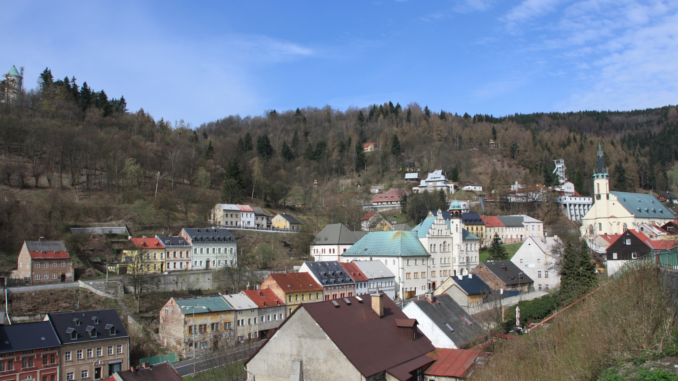
In a valley in the Bohemian region of the Czech Republic, near the German border, lies the small town of Jáchymov.
The valley is nestled in the Ore Mountains, a range known for its rich mineral waters, silver, bismuth, nickel, and other ores. Several towns in the area, including Jáchymov, have for decades catered to travelers and tourists who seek the health benefits of the mineral spas. More than a tourist destination, it turns out that Jáchymov played some interesting and important roles in history. (You just knew there was going to be history, didn’t you?)
In 1516, a mining settlement was founded at the site of an abandoned village. The settlement was called Sankt Joachimsthal, which is German for Saint Joachim’s Valley. The new village’s name came to be called Joachimsthal, for short.
The mineral that attracted miners to the location was silver, and there was a lot of it. The town and mines were owned by the von Schlick family, who used the silver to mint coins of a consistent size and weight. The coins were called Joachimsthalers, and they became a popular standard for currency throughout Europe because of their consistency. Needless to say, they made the von Schlicks very wealthy.
Eventually the name ‘Joachimsthalers’ became shortened to ‘thalers’, colloquially. Thus began an interesting etymology of a common word used around the world today. ‘Thal’ is old German for ‘valley’, and ‘thaler’ is old German for ‘valleys’. (In modern German they’re spelled ‘taler’ and ‘talers’). In related Germanic languages, ‘dale’, is old English for ‘valley’, and ‘daalder’ or ‘daler’, is from the Dutch. From ‘taler’ and ‘daler’, came a new word with new spelling: ‘dollar’.
‘Dollar’ had become a word in the English language by the year 1600. Notably, many countries around the world today, particularly former colonies of Great Britain, have their own dollar: for example, the Australian dollar, Canadian dollar, New Zealand dollar, and of course the American dollar, to name a few.
History wasn’t yet done with Joachimsthal. At the end of the nineteenth century, Polish-French physicist Marie Skłodowska Currie became interested in the ore from the Joachimsthal mines and subsequently discovered Polonium and Radium mixed in with the Uranium that had been discovered there more than a century before. These are the other ores the mines are now famous for. In the course of her scientific research, she coined the term radioactivity. For her discoveries, Madame Currie became the first woman to win a Nobel prize, the only woman to win a second Nobel, and the only person to win a Nobel in two different fields; Physics and Chemistry.
Mining has always been dangerous work, and Joachimsthal’s mines were even more so. Miners there had a shorter life expectency than average, but it took decades even after the discovery of radioactive elements in the ore to learn the truth. The danger of radioactivity wasn’t fully understood until the 1930s.
The discovery of Niton in 1900 led shortly thereafter to the introduction in Joachimsthal of the first radioactive spa in the world. You read that right. Niton was renamed Radon in 1923. Radon gas comes from the natural decay of Radium. As a result, there was a natural amount of radioactive Radon in the spa waters in Joachimsthal. To this day, the spas there attract people who believe there is a health benefit, and some doctors agree. (But before you make travel plans, you might want to look a little deeper into it).
After the First World War, Czechoslovakia was formed out of parts of the defeated Austro-Hungarian Empire. Joachimsthal became part of the new nation, even though the majority of the population were ethnic Germans who spoke German, not Czech. This was true for much of northern Czechoslovakia, which between the world wars was known in Germany as part of the Sudetenland. (Most people don’t realize it, but prior to the Second World War, there were pockets of German-speaking people all over Europe going back centuries).
Joachimsthal was in the heart of the Sudetenland, the territory that Neville Chamberlain ceded to Adolf Hitler in the 1938 Munich Agreement, and infamously declared “Peace For Our Time”. I expect most people know how that turned out.
After the Second World War, German speaking people were expelled from Czechoslovakia. Czech speaking people were moved in to Joachimsthal to take their place and the town was renamed Jáchymov.
During the Cold War (until at least 1964) Uranium mined from the Ore Mountains around Jáchymov went to the Soviet Union for the production of nuclear weapons. Czechoslovakia was, after all, part of the Soviet bloc.
With a current population of about 3,400 residents, Jáchymov is just a small town that has left a very large and wide historic legacy. VIDEO (8:00).
Question of the night: Where would you like to go for a vacation that you’ve never been to before?
